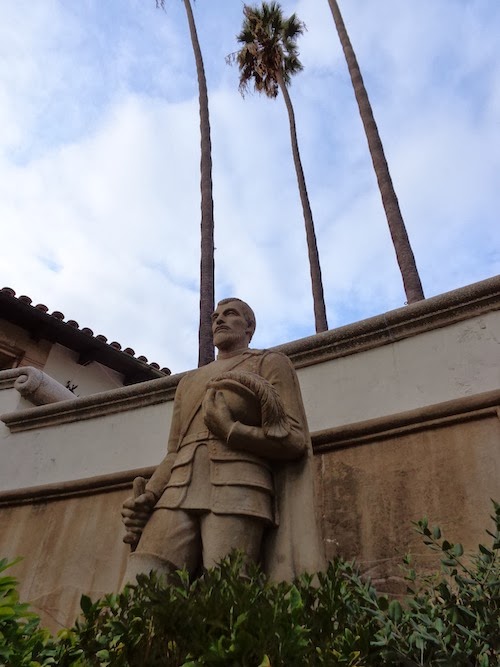The Bowers is one of the premier local repositories for artifacts of Orange County history, all the way from native Americans, through Spanish colonization and the missions, to Mexican rule, to American conquest. There are photographs, clothing, and other objects of historical importance. I began in the room dedicated to the native tribes of southern California, Orange County's original inhabitants.
The tribe which inhabited this area were known as the Kizh. The tribe is often erroneously called the Tongva, or Gabrielinos. But I recently met the chief of the tribe, Ernie Salas, and he assured me that they are called the Kizh, so that is what I will call them. The Kizh were expert basket weavers, and the museum contains some lovely examples of this. This one was my favorite:
There is an interesting display of "cogs" which are stone carvings. The exhibit explained that these "cogs" are a mystery, and their purpose remains unknown. I will be sure to ask the Kizh chief about this next time I see him.
The Kizh lived in this area for thousands of years, quite sustainably. But then, beginning in the 1700s, waves of conquest would permanently (and tragically) disrupt and alter their lives. The next exhibit room documents this sad history: From Spanish colonization to American conquest.
Here's a timeline of this history (with pictures and explanations):
1769: Father Junipero Serra (a Spanish Franciscan) arrives and founds the first Mission, San Diego de Alcala. Serra goes on to found many missions in California, which seek to convert the "heathen savages" and teach them the "superior" ways of European civilization.
1770: Gaspar de Portola, the Spanish soldier sent by the King of Spain to colonize California, leads a company of troops up California to Monterey, claiming the land for Spain (The land did not, in fact, belong to Spain). Here's a statue of Portola on the grounds of the Bowers Museum. He looks to be in a conquering mood.
1771: Mission San Gabriel is founded. Despite the romanticized portrayal of the missions we learn in fourth grade, the California Missions were basically slavery for native Americans. They were absolutely awful, and succeeded mainly in decimating the local tribes, like the Kizh, and eradicating a culture and language that had existed for thousands of years. One result of the missions is that the Kizh language is completely gone. No one alive today speaks it.
1776: Mission San Juan Capistrano, another institution of slavery and cultural desolation, is established.
1781: Pueblo of Los Angeles is founded as a farming community by a group of settlers from the Sinaloa and Sonora regions of Mexico.
1806: Jose Antonio Yorba, a soldier who served under Gaspar de Portola, is granted a Spanish land grant which encompasses large portions of present-day Orange County. The land had been taken from the Kizh people by this point. His son, Bernardo Yorba (whom Yorba Linda is named after) would continue to manage the large family estate. Here's a portrait of Bernardo Yorba (Dig those mutton chops!):
1812: The San Juan Capistrano Mission church is destroyed by an earthquake.
1821: Mexico wins its independence from Spain. Alta California becomes a Mexican province. Here's a photograph of Governor Pio Pico, the last Mexican governor of California, with some family members. Pio Pico was half black. See, California has a pretty progressive history (sort of).
1833: John Forster arrives in California. Forster was a conniving piece of shit. He was a Yankee who applied for Mexican citizenship, became catholic, changed his name to Juan, and married governor Pio Pico's sister Ysidora. Pico gave Forster huge land grants around present day San Juan Capistrano. And how did Forster repay his brother-in-law? By assisting the Americans in the Mexican-American War, which resulted in Mexico losing California. Nice.
1834: The California Missions are "secularized" (Meaning they no longer belong to the Catholic church). Who do they belong to? Well, "Juan" Forster got Mission San Juan Capistrano and started calling himself Don Juan Capistrano. What a douche.
1847: General Andres Pico, brother of Pio Pico, surrenders California to the Americans at the Treaty of Cahuenga in Los Angeles, after a bloody two-year armed struggle. California will soon become part of the United States.
Interestingly, the Bowers does not have much about the post-Mexican California. There is a small display called "The American Migration into the Golden State" and it has models of a sailing ship, a train, and a stage coach. I'm sure there is more to the story than that. But that's another blog post…














